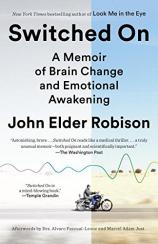Switched On: A Memoir of Brain Change and Emotional Awakening
Review
Switched On: A Memoir of Brain Change and Emotional Awakening
John Elder Robison established himself as a significant spokesperson for autism with his bestselling LOOK ME IN THE EYE. Now he recounts how, with an experimental therapy, he began to look people in the eye, seeing more there than he ever imagined.
In 2008, Robison was invited by two scientists, doctors Lindsay Oberman and Alvaro Pascual-Leone, to participate in research experiments to determine if TMS (transcranial magnetic stimulation) could help autistic people recognize and understand their emotions. Robison, who was diagnosed as an adult with Asperger’s Syndrome, and whose son and brother also have the syndrome, had made a success of his life by using his mechanical skills in a variety of profit-making ventures. He designed electronics for rock bands, including the iconic KISS, created robot games for Milton Bradley, and most recently started a business working on classic cars. None of these endeavors forced him to understand or empathize with humans, but he had managed that deficit in himself by making intellectual connections between himself and others. The notion that he might go further and learn to empathize was intriguing, and he agreed to take part in the project.
"[Robison] recounts how, with an experimental therapy, he began to look people in the eye, seeing more there than he ever imagined."
The initial result of the TMS experimentation was startling and intense; he began not only to hear music, but also to sense the passion of the lyrics. His wife suffered from depression, and for the first time, he had insights into her condition that made him feel the extent of her sadness. He realized that a man he had considered a friend had been mocking him all along. Those around him began to notice subtle changes in his attitude and his ability to speak to people like, well, people. Memories of his earlier life, times when he had reacted without apparent feeling to situations that called for emotion, flooded in. He began to feel that he had been emotionally “colorblind” most of his life. And one day he looked into the eyes of a stranger and saw depths of beauty and feeling there. His personal life was altered radically, and he is still sifting through the TMS experience.
Robison examines and explains the history and possible implications of TMS, but is careful to state his belief that since “there is no such thing as a typical brain” it will be difficult, no matter what the data, to draw conclusions based on comparisons between “different” and “neurotypical” humans. Though the effects of TMS in his case were scattered, not readily quantifiable and not sustainable, the technique showed promise because it helped him think about feeling, and that effect has lasted. Robison, who serves as a neurodiversity scholar in residence at the College of William and Mary, has come to regard the autistic experience as some sort of bridge between the workings of mind/brain (explicable logically) and feelings/heart (inexplicable but equally necessary for human progress).
Reviewed by Barbara Bamberger Scott on March 25, 2016
Switched On: A Memoir of Brain Change and Emotional Awakening
- Publication Date: February 7, 2017
- Genres: Memoir, Nonfiction
- Paperback: 320 pages
- Publisher: Spiegel & Grau
- ISBN-10: 0812986644
- ISBN-13: 9780812986648





